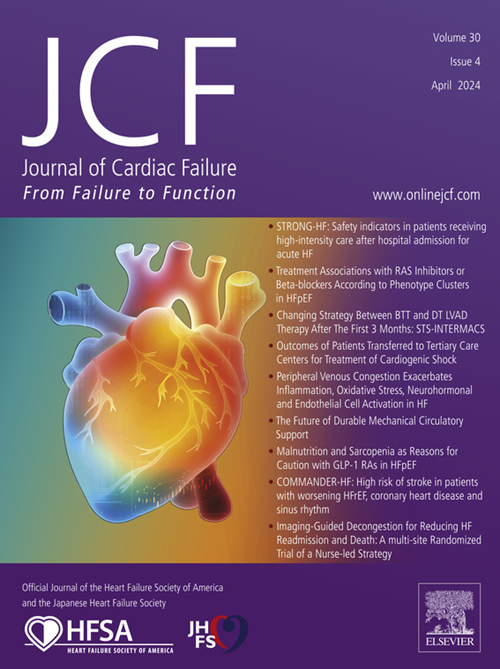Incidence Of Ventricular Tachycardia And Fibrillation Detected By An Insertable Cardiac Monitor In Patients With Symptomatic Heart Failure With Reduced And Preserved Ejection Fraction
IF 6.7
2区 医学
Q1 CARDIAC & CARDIOVASCULAR SYSTEMS
引用次数: 0
Abstract
Introduction
Subcutaneous insertable cardiac monitors (ICM) have the capability to detect tachycardia episodes which mostly includes supraventricular tachycardias (SVT) and occasionally ventricular tachycardia and fibrillation (VT/VF).
Hypothesis
We investigated the incidence of spontaneous VT/VF in NYHA class II/III heart failure (HF) patients with reduced and preserved ejection fraction using cardiac arrhythmia diagnostics measured by an ICM.
Methods
Patients with a recent history of HF events were implanted with an ICM equipped with tachycardia detection capability in the LINQ-HF and ALLEVIATE-HF phase-1 studies. ICMs detect tachycardia if 30 of 40 recent intervals are shorter than 260 ms or if 16 consecutive intervals are shorter than the tachycardia interval (nominally 340 ms) which is adjusted with age. Episodes are rejected if there is a large amount of baseline noise using a noise rejection algorithm. Tachycardia episodes that were detected by the ICM were first classified as VT/VF, SVT, or oversensing using an artificial intelligence (AI) model that was pre-trained using over 50,000 manually adjudicated ICM detected tachycardia episodes. If the AI model output probability for VT/VF was greater than 0.2, then those episodes were manually adjudicated for true incidence of non-induced spontaneous VT/VF. The Kaplan-Meier incidence curves for VT/VF incidence are reported as a function of reduced vs. preserved ejection fraction.
Results
The two studies had a combined 163 patients implanted with an ICM and followed for an average of 14.7±8.3 months. The baseline characteristics include average age of 67.2±11.2 years, 62.6% males, 55.2% with LVEF ≥ 50% (143 patients had LVEF measurements prior to implant), 16.6%% class-II and 83.4% class-III, and 55.2% with a clinical history of AF. There were 13 deaths and 14 device upgrades in the studies. There were 4 spontaneous polymorphic VT/VF episodes in 3 patients and 52 sustained monomorphic VT episodes in another 9 patients. The Kaplan-Meier incidence of VT/VF in the overall patient cohort was estimated to be 14% at 24 months. Patients with reduced and preserved EF had estimated incidence of 20% and 10%, respectively, at 24 months (Figure).
Conclusion
Incidence of VT/VF, as detected by an ICM and after manual adjudication of episodes after screening by an AI model over 2 years of follow-up, was estimated to be more than 14% in Class II/III HF patients with a history of HF events. VT/VF incidence was higher in HF patients with reduced vs. preserved LVEF in these study cohorts.
求助全文
约1分钟内获得全文
求助全文
来源期刊

Journal of Cardiac Failure
医学-心血管系统
CiteScore
7.80
自引率
8.30%
发文量
653
审稿时长
21 days
期刊介绍:
Journal of Cardiac Failure publishes original, peer-reviewed communications of scientific excellence and review articles on clinical research, basic human studies, animal studies, and bench research with potential clinical applications to heart failure - pathogenesis, etiology, epidemiology, pathophysiological mechanisms, assessment, prevention, and treatment.
 求助内容:
求助内容: 应助结果提醒方式:
应助结果提醒方式:


